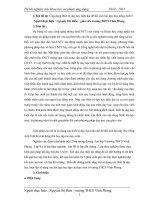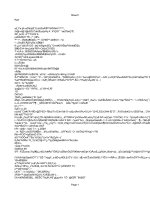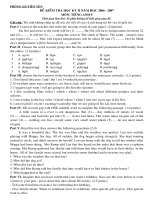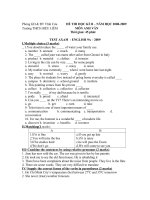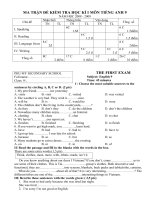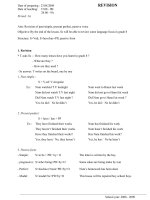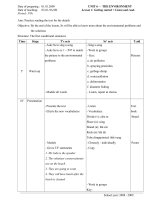TIẾNG ANH 9 - HK 1
Bạn đang xem bản rút gọn của tài liệu. Xem và tải ngay bản đầy đủ của tài liệu tại đây (381.72 KB, 66 trang )
Date of preparing : 23.08.2008 REVISION
Date of teaching: 15.08 - 9B
28.08 - 9A
Period: 1st
Aim: Revision of past simple, present perfect, passive voice
Objective: By the end of the lesson, Ss will be able to review some language focus in grade 8
Structure: S+Ved; S+have/has+PII; passive form
1. Revision
* T asks Ss : - How many tenses have you learnt in grade 8 ?
- What are they ?
- How are they used ?
- Ss answer. T writes on the board, one by one
1. Past simple :
S + V-ed/ V-irregular
Ex: Nam watched T.V lastnight Nam went to Hanoi last week
Nam did not watch T.V last night Nam did not go to Hanoi lat week
Did Nam watch T.V last night ? Did Nam go to Hanoi lat week ?
Yes, he did / No he didn’t Yes, he did / No he didn’t
2. Present perfect:
S + have / has + PP
Ex : They have finished their works Nam has finished his work
They haven’t finished their works Nam hasn’t finished his work
Have they finished their works? Has Nam finished his work?
Yes, they have/ No, they haven’t Yes, he has / No he hasn’t
3. Passive form:
- Simple: S+to be + PII+ by+ O The letter is written by the boy
- progressive: S+tobe+being+PII+by+O Some cakes are being make by Lan
- Perfect: S+has/have+been+PII+by+O Nam’s homework has been done
- Modal: S+modal+be+PII+by+O This house will be repaired boy school boys
School year: 2008 - 2009
2. Practice:
Exercise 1 :
Choose the best answers :
T asks ss to copy the exercise and do individually.
1. I (saw, see, have seen) elephants.
2. They will (come, came, to come) to the party.
3. Nam asked me (whether, do, did) I were Hoa’s friend.
4. Bicycle (is invented, invented, was inverted) in 1816.
5. The cake (make, was make, was made ) by my mother.
Exercise 2 :
Put the verbs in brackets in the correct forms : Key:
1. Mai (not go) to the park last Sunday. Did not go
2. When I (arrive) home, my mother (cook) dinner. Arrived/ was cooking
3. Lan (can) swim when she (be) 6 years old. Could / was
4. Nam said that he (will) repair the bike. Would
5. I asked Hoa if she (see) the news last night. Saw
6. Rice (grow) in Viet Nam is grown
Exercise 3 :
Change these sentences into the passive : Key:
1. Mrs Lan made spring rolls yesterday. The spring rolls are made in the spring
2. Nam often repairs his bike. Nam’s bike often repaired
3. The children did not make noise this morning. The noise wasn’t made by the children
4. Mr Alexander Bain invented the fascimile. The fascimile was invented by Mr Alexander
5. Have you finished his work? Has his work has been finish?
School year: 2008 - 2009
Date of preparing : 23.08.2008 Unit 1 a visit from a penpal–
Date of teaching: 30.08.2008-9A,9B Lesson 1: Getting started + Listen and read.
Period: 2nd
Aim: Practice reading the text for the details
Objective: By the end of the lesson, Ss will be able to talk about activities with their friends
Structure: Past simple tense; Past simple with “ WISH ”
Time Stage T’s acts Ss’ acts T.aid
5’ Warm up
- Chats with Ss
1. Do you have a penpal?
2.Where does he/she live?
3.Where would you visit if he
came here?
- Asks Ss to talk about the
pictures on P.6
1. What is the picture about?
2. Do you like visiting there?
- Answer T’s questions
- Discuss
- Keys:
a. Hung Kings temple ( Phu Tho )
b. Temple of literature ( Ha Noi )
c. Dong Xuan market ( Ha Noi )
d. History museum ( Ha Noi )
e. Restaurant
f. HaNoi opera house ( Ha Noi )
Pictures
10’ Presentation - Presents the text
- Elicits the new vocabularies
- Gives Ss some questions
comprehension
- Listen
- Vocabulary:
+ correspond-v: trao đổi thư tín
+ to be impressed-(pas):gây ấn tượng
Eg: I am impressed ..
He is impressed ..
+ mosque-n: nhà thờ hồi giáo
+ pray-v:cầu nguyện
+ Hinduism-n: đạo Hindu
+ Buddism-n: đạo Phật
- Q/s comprehension:
a. Where does Maryam come from?
b. How often does she come to Lan?
c. Did Maryam want to invite Lan to
Kuala Lumper?
Text
book
Board
Poster
School year: 2008 - 2009
- Asks Ss to give the guessing - Work in groups
Time Stage T’s acts Ss’ acts T.aid
20’ Practice
- Asks Ss to read the text on P6,7
then check the anwers
- Asks Ss to do ex on P7
- Read
- Keys
a. Maryam comes from Malaysia
b. It’s the first time she comes to Lan
c. Yes, she did
- Work in pairs
- Keys:
1 – c 2 – b 3 – d 4 – b
Text
book
7’ Production
- Presents the past simple with “
WISH ”
+ form:
S + wish(es)+ S + past simple
Eg:
a.I wish I had a longer vacation.
b.She wishes she knew a lot of
friends
+ using: Unreal in the present.
Eg: I’m very short.
I wish I were taller
+ note: Tobe WERE
- Make the sentences using the past
simple with “ WISH ”
a. I don’t have a sister
I wish I had a sister.
b. He doesn’t learn English very well
He wishes he learnt English well.
c. I’m very thin
I wish I were fatter
…
Poster
3’ Homework
- Read again the text.
- Do ex 3 – P7 – Workbook
- Be ready for the next lesson
* Self – evaluation :
Content: ...............................................................................................................................................................
Methods:...............................................................................................................................................................
Results:.................................................................................................................................................................
School year: 2008 - 2009
Date of preparing: 30.8.2008 UNIT 1 – A VISIT FROM A PENPAL
Date of teaching: 4.9.2008-9A Lesson 2: Speak + Listen
6.9.2008-9B
Period: 3rd
Aim: Practice speaking and listening.
Objective: By the end of the lesson, Ss will be able to make and respond to introductions, listen to the
special information to select the correct pictures.
Structure: Past simple tense, the past simple with “WISH”
Time Procedure T’s activities Ss’ activities T.aid
5’ Warm up
- Chats with Ss, asking about Viet
Nam:
1. Area
2. Population
3. Currency
4. Capital city
5. National language
- Answer the q/s:
1. In South east of Asia
2. about over 80 million
3. dong
4. Ha Noi
6. Vietnamese
poster
10’ Pre-speaking
- Asks Ss to look at the dialogue
between Nga and Maryam on P
88, the order the dialogue
- Asks Ss to practice the
completed dialogue.
- Work in groups
- Key:
1 – c – 5 – b – 4 – d – 2
– e – 3 – a – 6
- Work in pairs
Text
book
20’ While-speaking
- Divides the class in to three
groups
G1: talking to Yoko
G2: talking to Paul
G3: talking to Jane
- Asks Ss to read the information
about Yoko, Paul and Jane.
- Asks Ss to make the dialogue to
introduce Yoko, Paul and Jane
- Work in groups
- Read
- Work in pairs
- Eg:
A: Hello. You must be Yoko
Y: Yes, I am
poster
Time Procedure T’s activities Ss’ activities T.aid
A: Please to meet you. I’m
School year: 2008 - 2009
Ngoc
Y: Please to meet you, Ngoc.
Are you one of Lan’s
classmate?
A: Yes, I am. Are you enjoying
your stay in VN?
Y: Oh, yes, very much . I like
Vietnamese people. They are
very friendly. I love old cities in
VN as Ha Noi and Hoi An
A:....
Y:....
7’ Post-speaking
- Asks Ss to look at the pictures
on P9 to give the meaning of each
- Asks Ss to listen to the tape give
the correct pictures
- Key:
A-1: Don’t walk on the grass
2: Don’t pick up the flowers
B-1: The red bus number is 103
2:The blue bus number is 130
C-1: Amexican restaurant
2: An USA restaurant
- Listen and check
Key:
A – 1
B – 1
C – 2
3’ Homework
- Be ready for next lesson
- Review the past simple
tense
VI. Self – evaluation :
Content: .............................................................................................................................................................................................
Methods: ...........................................................................................................................................................................................
Results: .............................................................................................................................................................................................
Date of preparing : 01.09.2008 Unit 1 a visit from a penpal–
Date of teaching: 6.9 – 9A Lesson 3: Read
9.9 – 9B
Period: 4th
School year: 2008 - 2009
Aim: Practice reading
Objective: By the end of the lesson, Ss will be able to know more about Malaysia
Structure: Past simple tense; Past simple with “ WISH ”
Time Stage T’s acts Ss’ acts T.aid
5’ Warm up
- Asks Ss some q/s about Viet
Nam to fill in the poster
- Answer T’s questions
1. Area:
2. Population
3. Currency
4. Capital city
5. National language:
Poster
10’ Pre-reading
- Presents vocabs
- Models
- Give some T/F predictions
- Asks Ss to give predictions
- Vocabulary:
+ to be divided-(pas): đ ược chia ra
+ to be separated-(pas): phân chia
+ comprise-v: gồm có
+ unit of currency-n: đơn vị tiền tệ
+ religion-n: tôn giáo
+ Islam-n: đạo Hồi
+ Hinduism-n: đạo Hindu
+ Buddism-n: đạo Phật
- repeat in chorus, individually
* T/F
1. Malaysia is a member country of
Asian.
2. There are two religions in Malaysia
3. People speak only Malay in
Malaysia
4. Primary school children learn three
languages at school.
5. All secondary school children learn
English.
- Work in groups
Board
Poster
Time Stage T’s acts Ss’ acts T.aid
20’ While-
reading
- Asks Ss to read the text on
P9,10 then check their
predictions
- Read the text then check
- Keys
1.T
Text
book
School year: 2008 - 2009
- Asks Ss to fill the information
about Malaysia on the poster
2.F (...3 religions)
3. F (...EL,Chinese,Tamil and Malay)
4. F ( one of three)
5. F ( EL is a compulsory second
language)
- Work in pairs
- Keys:
MALAYSIA
1.Area: 329.758 sqkm2
2. Population: >22 milion
3. Climate: tropical
4. Currency: ringgit
5. Capital city: Kuala Lumpur
6. Offical religion: Islam
7. National language: Bahasa
8. Compulsory second language: EL
Poster
7’ Post-reading
- Asks Ss some q/s about
Malaysia
1. Where is Malaysia?
2. Hoaw manay religions are
there in Malaysia?
3. Which is the capital city of
Malaysia?
- Answer q/s
1. Malaysia is in Asia
2. There are 3
3. It is Kuala Lumpur
3’ Homework
- Read again the text.
- Do ex 3 – P7 – Workbook
- Be ready for the next lesson
* Self – evaluation :
Content: ...............................................................................................................................................................
Methods:...............................................................................................................................................................
Results:.................................................................................................................................................................
Date of preparing : 07.09.2008 Unit 1 a visit from a penpal–
Date of teaching: 13.9.2008 -9A,9B Lesson 4: Write
Period: 5th
Aim: Practice writing
Objective: By the end of the lesson, Ss will be able to a personal letter to family
School year: 2008 - 2009
Structure: Past simple tense; Present perfect tense
Time Stage T’s acts Ss’ acts T.aid
5’ Warm up
- Chats with Ss
1. Did you go to the seaside last
summer?
2.Did you visit some places of
interest?
3.What did you buy for friends?
For Mom? For Brother?...
- Answer T’s questions
10’ Pre-writing
- Presents the situations
“Imagine you are visiting your
relative or friends in other part of
VN. Write a letter to your family”
- Gives the out line
- Asks Ss to review the format of
a letter
- Preview the present perfect
S+has/have+past participle
- copy the out line
- When you arrived ?
- Who you met? Where ?
- What places you visited ?
- What kind of food you tried?
- What thing you’ve bought?
- How you feel now?
A-Heading: Address and date
B-Opening: Dear,....
C-Body of letter
D-Closing: Your.......,
Love.......,
- Give some examples
1. I have visited Phong Nha cave
2. He has bought some presents
Poster
Time Stage T’s acts Ss’ acts T.aid
20’ While-writing
- Asks Ss to write the letter - Write
- eg:
Dear,Mom and Dad,
I arrived Nha Trang at 6 last week.
My friend, Nam, met at the airport.
poster
School year: 2008 - 2009
When we arrived the sun was shining.
Nha trang is beuatiful, I’ve visited
Peal Island, Nha Trang beaches, I’ve
tried lots of sea food as scraps,
fishes...
Yesterday, I’ve bought some small
sourvenirs for you and my friends. I’ll
come back on Sunday
Your faithfully,
Mai
7’ Post-writing
- Asks Ss to read the letter before
class.
- Read
- Give the remarks
Poster
3’ Homework
- Copy the letter on note book
- Review the past simple
- Be ready for the next lesson
* Self – evaluation :
Content: ...............................................................................................................................................................
Methods:...............................................................................................................................................................
Results:.................................................................................................................................................................
Date of preparing : 14.09.2008 Unit 1 a visit from a penpal–
Date of teaching: 16.9 - 9B Lesson 5: Language focus
20.9 - 9A
Period: 6th
Aim: Futher practice in using the past simple tense and past simple wish WISH
Objective: By the end of the lesson, Ss will be able to use the past simple tense ,past simple wish WISH well
Structure: Past simple tense; past simple wish WISH
Time Stage T’s acts Ss’ acts T.aid
5’ Warm up - Asks Ss to read some verbs, then
match the verb in A with it’s past
- Read
- Match
School year: 2008 - 2009
form in B A B
1.go a. bought
2.do b. went
3.see c. made
4.make d. did
5.buy e. saw
- Key:
1-b ; 2-d ; 3-e ; 4-c ; 5-a
poster
10’ Presentation
- Review the past simple tense
using questions
1. What’s the form ?
2. What does it mean?
3. What is it used for?
- Review the past simple with
WISH
- Ask Ss give some eg
- Revision
- Answer q/s
1.Form: V+ed / Irregular verb
2. meaning: đ ã
3. using: express an activity which
happen in the past
- Key:
1.Form:
S+ wish/wishes+S+past simple/were
2. meaning: ước, muốn
3. using: “WISH” is used when we
want really to be different and exactly
oppsite of the time
- Give some examples
1. I wish I were taller
2. He wishes he were taller
Poster
Time Stage T’s acts Ss’ acts T.aid
20’ Practice - Asks Ss to do ex 2 - P12
- Asks Ss to copy the anwers on
board
- Asks Ss to do ex 3 – P12
- Work in groups of four
- Key:
1. Lan made a cake
2. Hung hung the colorful lamps
3. Hoa bought the flowers
4. Tuan painted a picture of Ha Noi
5. Hoa and Maryam went shopping
- Copy on board – check
- Work in pairs
poster
board
School year: 2008 - 2009
- Key:
b.I wish I were in the siwmmimg pool
c.I wish I had a computer
d.I wish I lived near school
I wish I didn’t live far from school
e.I wish I had a sister
f. I wish I drew well.
g.I wish I knew my friend’s phone
number.
h. I wish I know many friends.
i. I wish there were some rives and
lakes in my hometown
7’ Production
- Asks Ss to do Ex 6 - WB Exercise 6.
a) Study at a primary school.
I studied at a primary school 5 years
ago.
a) I donot know many English words
( I need more words to talk with my
friends).
I wish I knew more English words.
Class, do the exercises.
Poster
3’ Homework
- Do all ex again
- Be ready for the next lesson
* Self – evaluation :
Content: ...............................................................................................................................................................
Methods:...............................................................................................................................................................
Results:.................................................................................................................................................................
Date of preparing : 15.09.2008 Unit 2 Clothing–
Date of teaching: 20.9 – 9A Lesson 1: Getting started + Listen and read
23.9 – 9B
Period: 7th
Aim: Reading the text for the details
Objective: By the end of the lesson, Ss will be able to know more about clothing, especial “Ao dai ”
Structure: Present perfect, passive form
Time Stage T’s acts Ss’ acts T.aid
5’ Warm up - Asks Ss to match the word in A
with suitable one in B
+ Matching
A B
1.Viet Nam a. kimono
2.USA b. saria
3. Scotland c. ao dai
poster
School year: 2008 - 2009
- Asks Ss to look at the pictures
on P13 then answer the question:
Where does he/she come from?
4. Arabia d. jeans
5. Japan e. kilt
6. India f. veil
- Key:
1-c ; 2-d ; 3-e ; 4-f; 5-a; 6-b
- Anwer the questions:
a. She comes from Japan
b. She comes from Viet Nam
c. He comes from Scotland
d. She comes from India
e. He comes from USA
f. She comes from Arabia
10’ Presentation
- Presents vocabulary
- Models
- Gives some T/F predictons
- Copy
+ a long silk tunic: áo lụa dài
+ slit: xẻ
+ loose ≠ tight : rộng ≠ chật
+ Convenient: tiện lợi
+ Poet, poem, poetry: nhà thơ, thơ,
+ inspriration: cảm hứng
+ design – designer: thiết kế
- Chorusly - individually
* T/F ?
1. Men and women used to wear ao dai
Poster
Time Stage T’s acts Ss’ acts T.aid
- Asks Ss to do ex 2 - P12 2. The women prefer to wear ao dai at
work because it is convenient
3. The ao dai now is unfashionable
20’ Practice
- Asks Ss to read the text about
the ao dai for details
- Asks Ss to read the text again
then do exercise on P14
Read the check the predictions
1. T
2. F
3. F
- Practice
a. Work in groups
1. poems, novels and songs
poster
text
book
School year: 2008 - 2009
2. long silk tunic with slit up the side
3. to wear morden clothing at work
4. lines of poetry on it
5. traditional designs and symbols
b. Work in pairs
1. Both men and women
2. Because it is convenient
3. They added traditional designs and
symbols like suns, stars, crooses.....
7’ Production
- Asks Ss to read the text aloud
before the class
- Read
- Give the remark
Text
book
3’ Homework
- Read the text again
- Be ready for the next lesson
* Self – evaluation :
Content: ...............................................................................................................................................................
Methods:...............................................................................................................................................................
Results:.................................................................................................................................................................
Date of preparing : 20.09.2008 Unit 2 Clothing–
Date of teaching: 23.9 – 9B Lesson 2: Speak
25.9 – 9A
Period: 8th
Aim: Practice speaking
Objective: By the end of the lesson, Ss will be able to ask and respond to questions on personal preferences
Structure: Wh-questions/ It is said that....
Time Stage T’s acts Ss’ acts T.aid
5’ Warm up - Asks Ss to sing a song - Sing a song poster
10’ Pre-speaking
-Ask Ss to match the phrases to
the pictures
+ Matching
a. 1 – a colorful T-shirt
School year: 2008 - 2009
- Presents vocabulary
- Elicits vocab by asking q/s
1. What is it?
2. What are thay?
- Models
b. 5 – a sleeveless swearter
c. 6 – a striped shirt
d. 3 – a plain suit
e. 8 – faded jeans
f. 4 – a short sleeved blouse
g. 7 – baggy pants
h. 2 – a plaid skirt
i. 9 – blue shorts
- Copy
+ plaid: kẻ ca rô
+ plain: trơn (ko hoa, hvẽ )
+ sleeveless: cộc tay
+ fade: bạc màu
- Chorusly – individually
Poster
Time Stage T’s acts Ss’ acts T.aid
20’ While
speaking - Asks Ss to write two more
questions on the survey form
- Asks Ss to do the survey
- Work in groups
* Survey:
Name Clothes idea
1.......
2............
3.........
4...........
5...........
*Q/s:
1. What do you usually wear on the
poster
work
sheets
School year: 2008 - 2009
shorts
weakend?
2. Why do you wear these clothes?
3. What is your favorite type of
clothing? Why ?
4. Is school uniform comfortable?
5. What color is it?
7’ Production
- Asks Ss to report their survey - Report the survey:
Eg: lan said she liked....
- Give the remark
Task
sheets
3’ Homework - Rewrite the report on note book
- Be ready for the next lesson
* Self – evaluation :
Content: ...............................................................................................................................................................
Methods:...............................................................................................................................................................
Results:.................................................................................................................................................................
Date of preparing : 27.09.2008 Unit 2 Clothing–
Date of teaching: 01.10 – 9B Lesson 3: Listen
03.10 – 9A
Period: 9th
Aim: Practice listening
Objective: By the end of the lesson, Ss will be able to describe what people are wearing by listening a public
announcement.
Structure: Present progressive, present perfect
Time Stage T’s acts Ss’ acts T.aid
5’ Warm up
- Asks Ss to list some type of
clothes
- Asks Ss some q/s about their
fashion:
1. What type of your favorite
*Brainstorming poster
School year: 2008 - 2009
clothes
skirt
Ao dai
clothes?
2. ....
10’ Pre-listening
-Elicits the new vocab
- Models
- Gives questions comprehension
1. How old is Mary?
2. What is she like?
3. What is she wearing?
- Copy
+ announcement: thông báo
+ missing = lost: thất lạc
+ entrance: cổng vào
+ fair: hội chợ
- Chorusly – individually
- Give the guessing
Poster
Time Stage T’s acts Ss’ acts T.aid
20’
While
listening
- Asks Ss to listen to the tape
carefully and check the correct
picture P.16
- Asks Ss to listen to the tape
again then answer the questions
comprehention
- Listen and check
- Key:
a – B: blue shorts
b – A: white long sleeved blouse
c – C: brown shoes
- Work in pairs
- Key:
1. She is 5 years old
2. She has short dark hair
3. She is wearing blue shorts, a white
long sleeved blouse and a pair of brown
shoes.
Text
book
work
sheets
7’ Post listening - Asks Ss to describe Mary - Describe person :
Eg: The missing litter girl is Mary, she
is 5 years old, she has a short dark hair,
Task
sheets
School year: 2008 - 2009
clothes
skirt
Ao dai
- Ask Ss to do ex 2 – P13 - WB
she is wearing blue shorts, a white long
sleeved blouse and a pair of brown
shoes.
- Work in groups
- Key:
a. bought
b. has had
c. arrived/had/went
d. Have you visited...?
e. have taken
3’ Homework
- Do all exercise again
- Do ex 4 – P 15 - WB
- Be ready for the next lesson
* Self – evaluation :
Content: ...............................................................................................................................................................
Methods:...............................................................................................................................................................
Results:.................................................................................................................................................................
Date of preparing : 27.09.2008 Unit 2 Clothing–
Date of teaching: 03.10 – 9A ,9B Lesson 4: Read
Period: 10th
Aim: Practice reading
Objective: By the end of the lesson, Ss will be able to know more about clothes, especially about Jeans
Structure: Present perfect, passive voice
Time Stage T’s acts Ss’ acts T.aid
5’ Warm up
- Uses the picturea on the text
book to elecit the pupils
1. How many people are there in
the picture?
2. Are they students?
3. What clothes are they wearing?
- Anwer the questions
1. There are five
2. Yes, they are
3. They are wearing Jeans
poster
10’ Pre-reading
- Presents new vocab - Copy
School year: 2008 - 2009
- Models
- Gives some pre-questions
1. Where does the word “Jeans”
come from?
2. What were the 1960’s fashion?
3. Were Jeans high fashion
clothing?
4. Why did the sale of Jeans stop
growing?
+ material: v ải, chất liệu
+ sailor: thuỷ thủ
+ cotton: s ợi bông
+ wear out: khó rách
+ embroider: thêu
+ style: kiểu dáng
+ sale: doanh thu
- Chorusly – individually
- Work in pairs
Poster
Time Stage T’s acts Ss’ acts T.aid
20’
While
reading
- Asks Ss to read the text for the
detail
- Asks Ss to work in groups to do
ex a – P17
Asks Ss to read the text again, the
do ex b – P18
- Read
- Work in groups
- Key:
1. 18
th
century / Jeans clothes
2. 1960s / Students
3. 1970s / cheaper
4. 1980s / fashion
5. 1990s / sale
- Work in pairs
1. The word “Jeans” comes from a kind
of material that was made in Europe.
2. The 1960’s fashions were embroided
Jeans, painted Jeans, and so on...
3. Because the Jeans became cheaper
Text
book
work
sheets
7’ Post reading - Asks Ss to use the suggested - Work in pairs
School year: 2008 - 2009
words to make sentences a. Jeans / make / cotton
b. Youngers / fond of / wear / jeans
c. The jeans / labels / them / now
Task
sheets
3’ Homework
- Do all exercise again
- Do ex 4 – P 15 - WB
- Be ready for the next lesson
* Self – evaluation :
Content: ...............................................................................................................................................................
Methods:...............................................................................................................................................................
Results:.................................................................................................................................................................
Date of preparing : 27.09.2008 Unit 2 Clothing–
Date of teaching: 04.10 – 9A ,9B Lesson 5: Write
Period: 11th
Aim: Practice writing
Objective: By the end of the lesson, Ss will be able to write an exposition
Structure: An argument
Time Stage T’s acts Ss’ acts T.aid
5’ Warm up
- Writes some English words on
board
- Read in Vietnamese meaning or
in English
* Slap the words
- uniform
- casual clothes
- size
- self confident
- comfortable
- color
poster
10’ Pre-writing
- Asks Ss some question
1. Do you like wearing uniform or
casual clothes ? why ?
- Presents the argument
It’s used to persuade readers to
- Answer the question
- Look at the argument
School year: 2008 - 2009
brlive or do someting
- Asks Ss to read the out line A.
P18
- Presents vocab
- Asks Ss to read the passage on
P18,19
- Read
- Copy
+ encourage – v:
+ to be equal in:
+ to be proud of:
+ to bear one’s name:
+ freedom of choice:
+ self confident:
- read
Poster
Time Stage T’s acts Ss’ acts T.aid
20’ While writing
- Asks Ss to read the out line B
P.19
- read and discuss
- write:
+ key:
I think it’s necessary for secondary
school students to wear casual clothes
when they are at school.
- Firstly, wearing casual clothes
makes Ss feel comfortable. They can
run, play games, play sports, etc...
- Secondly, wearing casual clothes
gives Ss free dom of choice. They can
choose their size, favorite colors and
fashion,...
- Thirdly, wearing casual clothes
makes Ss feel self confident when they
are in thier favorite clothes.
- Finally, wearing casual clothes
makes school more colorful and lively
- Therefore, The secondary school
students should wear casual clothes
when they are at school.
Text
book
poster
School year: 2008 - 2009
7’ Post writing
- Asks Ss to hung their writing on
board
- Ask Ss to read their passage
- hung the poster
- read aloud before class
poster
3’ Homework
- Copy the writing on note book
- Review the passive voice
- Be ready for the next lesson
* Self – evaluation :
Content: ...............................................................................................................................................................
Methods:...............................................................................................................................................................
Results:.................................................................................................................................................................
Date of preparing : 04.10.2008 Unit 2 Clothing–
Date of teaching: 07.10–9B Lesson 6: Language focus
09.10 - 9A
Period: 12th
Aim: Revision of the present perfect tense and the passive form
Objective: By the end of the lesson, Ss will be able to use the present perfect tense and the passive form to do
exercises well
Structure: have/has + PII; irregular verbs; passive voice.
Time Stage T’s acts Ss’ acts T.aid
5’ Warm up
- Gives a dialouge with some
missing prepositions and asks Ss
to do it
- Asks Ss to practice the dialouge
- Work in groups
Nga: Come and see my photo album.
Mi: Lovely! Who is this?
Nga: Ah! It’s Lan, my old friend
Mi: How long have you known her?
Nga: I’ve known her..........six years
Mi: Have you seen her recently?
Nga: No, I haven’t seen her .........2003
- Key:
For/ since
poster
10’ Presentation
- Reviews the present perfect
tense:
- Copy
a. already: is used in affirmative
School year: 2008 - 2009
+ form: S + has/have + PII
- Asks Ss to read the out line A.
P18
- Presents vocab
- Reviews passive form
sentences
position: mid sentence
b. Yet; is used in negative sentences
and questions
position: and of sentence
c. Ever: is used in question
position: after Subjects
- Copy
+ simle tense: Be + PII
+ progressive tense: Be + being+ PII
+ perfect tense: have/has + been + PII
+ modal verb: Modal verb + be +PII
Poster
Time Stage T’s acts Ss’ acts T.aid
20’ Practice
- Asks Ss to do ex 2 - P.20
- Asks Ss to do ex 4 - P.21
- Asks Ss to do ex 5 - P.21
- Work in pairs
S1: Have you seen Giac Lam pagoda
yet ?
S2: Yes, I’ve already seen it
S1: Have you eaten Vietnamese food
yet ?
S2: No, I haven’t
- Work in groups
+ key:
a. Jean clothes was made from cotton
in the 18
th
century
b. Rice is grown in tropical countries
c. Five milion bottles of champague
will be produced in Frence next
year.
- Work in groups
+ key:
a. the problem can be soled
b. Experiment on animals should be
stopped
c. The life on another planet might be
found
Text
book
poster
School year: 2008 - 2009
7’ Production - Asks Ss to copy the anwers on
board
- Correct board
3’ Homework
- Copy the writing on note book
- Do all exercises again
- Be ready for the next 45’ test
* Self – evaluation :
Content: ...............................................................................................................................................................
Methods:...............................................................................................................................................................
Results:.................................................................................................................................................................
Date of preparing : 04.10.2008 Eng lish test 45’
Date of teaching: 14.10 - 9A ,9B
Period: 13th
I. Listen to the speaker and answer the questions (2,5pts)
1. What is the lost litte girl name?.................................................................
2. How old is she?.........................................................................................
3. What is she like?.......................................................................................
4. What is she wearing?.................................................................................
5. Who is waiting for her?.............................................................................
II. Read the following passage and choose the best answer A,B,C or D for the question below(2pts)
THE WET SEASON IN INDONESIA
Between the months of November and May a wind blows from the west in most parts of Indonesia. It
comes from the ocean and carries rain. Clouds build up around the mountains, and every afternoon rain falls.
The rain is always heavy, and rivers can be walked across in the dry season now become dangerous. When it
rains the whole day, they may suddently overflow and cause great damage to the land.
Most farmers are glad when the wet season begins. There is water for their fields and they can again
start growing rice. But people in town are not so glad for the streets soon get muddy and dirty. They prefer the
dry seasons when they can sit outside and enjoy the cool evening.
1.When is the wet season? 2. What causes the rainfall?
a. in May a. The ocean
b. in November b. Clouds building up around
c. From November to May c. The mountains
d. From May to November d. The afternoon
3.What damages the land? 4.Why are people in town not so happy?
a.The sudden rain a.They can sit outside
School year: 2008 - 2009
b.The overflow of the rivers b.They are muddy and dirty
c.The wet season c.The evenings are cool
d.The dry season d.The streetsare full of mud
III. Choose the best option A,B,C or D to complete the following sentences(1,5pts)
1.The Kimono is the ........................dress of Japan people
A. casual B. traditional
C. convenient D. fashionable
2. Her ..........................handkerchief looks very nice. She has spent the whole week making it.
A. embroidered B. embroidere
C. embroidery D. embroidering
3. Wearing..........................makes students feel .........................at school
A. jeans/proud B. jeans/convernient
C. uniforms/self-confident D. uniforms/practical
4. The ao dai is usually made of a light......................
A. cotton B. leather
C. jean D. material
5. Japanese people usually wear Kimonos on special................................
A. times B. occasions
C. situations D. places
IV. Rewrite these sentences using the words suggestion (1,5pts)
1. Mai doesn’t have a computer (wish) ...............................................................................................
2. Nam hasn’t finished his works (passive) ........................................................................................
3. The chidren wrote the big letter yesterday(passive) ...........................................................................
V. Write a paragraph of about 60 words suporting the argument that secondary schoolgirls should wear
“aodai ” as a uniform, using the following suggestions.
- look very beatiful
- feel proud of their beauty, make them more self-confident
- make them behave more charming and politely
- both traditional and fashionable
- make schools more colorful and lively
..............................................................................................................................................................................
..............................................................................................................................................................................
..............................................................................................................................................................................
..............................................................................................................................................................................
..............................................................................................................................................................................
..............................................................................................................................................................................
..............................................................................................................................................................................
School year: 2008 - 2009

